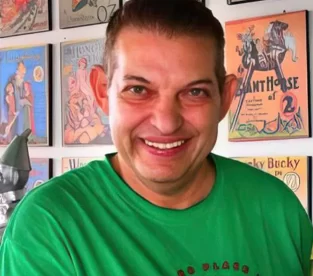The Wizard of Oz Science Center. A new way to engage children with science.
Science is a way of knowing about the world, and Frank Baum’s imaginary world has many.
The Wizard of Oz Museum is also a Science Center since the original story encaptures many Science elements.
Baum would pen over 70 books under several pseudonyms and tried his hand at science fiction, demonstrating a knack for predicting the future on par with H.G. Wells. A running theme in Baum’s work was the triumph of technology over distance and time. Some of his fictional inventions—televisions (master key), satellites, cell phones( tik-tok), laptops( master key), robots ( Ozma of Oz, the first mention of robot in English literature), augmented reality ( Master Key)—eventually became realities of everyday life.
Below is an example from Frank Baum’s book Tik-Tok of Oz ( 1914), where Frank Baum predicted the wireless phones.
…Shaggy suspected the truth, and believing that Ozma was now taking an interest in the party he drew from his pocket a tiny instrument which he placed against his ear.
Ozma, observing this action in her Magic Picture, at once caught up a similar instrument from a table beside her and held it to her own ear. The two instruments recorded the same delicate vibrations of sound and formed a wireless telephone, an invention of the Wizard. Those separated by any distance were thus enabled to converse together with perfect ease and without any wire connection.
“Do you hear me, Shaggy Man?” asked Ozma.
“Yes, Your Highness,” he replied.
Baum predicts Internet news, a device more powerful than a lie detector (it could label people good or evil), bulletproof vests (they are electrical but still cool), and other products in the Master Key story.
Other science elements from the Original book and the movie – Wizard of Oz Science Center in the Orlando area
In addition, many things fly in the Wizard of Oz story and the movie, such as monkeys, brooms, hot air balloons, houses, bikes, and even cows.
From the Tornado as a natural phenomenon in the book and the movie, visitors can analyze movie elements that make a tornado. The only common thing with real-life tornadoes probably has to do with wind and dirt. In real life, air masses are colliding, updraft, funnel draft, rear flank downdraft, funnel cloud, etc.
Rainbow is all about color. A rainbow is a natural phenomenon caused by sunlight bending in the correct atmospheric conditions. Visual experiments can be created at home with kids, from the rainbow concept utilizing the museums as a science center.
What about flying monkeys? They do not exist, but did you know monkeys fly into Space? Researchers sent animals to learn about the effects of spaceflight on living beings. In 1959, in the early days of space exploration, the USA sent two monkeys to space aboard a Jupiter rocket and retrieved them unharmed.
Covering the Universe, the museum utilizes James Webb’s images and Immerse visitors into Space, which is also part of the Science Center of the museum. The Cowardly Lion of Oz book is about the Moon being a balloon held by the Sandman, and in another title, Queen Zixi of Ix has the fairies of Burzee asking the Man in the Moon to decide on the recipient of their newly-made magic cloak.
Dorothy throws water on the witch, and the witch melts. This fact of physics can be experimented at home as a science experiment for kids. You can take an old cotton candy, and observe melting in the water.
Have you ever wondered how the Wicked Witch took a bath? Astronauts in space have that exact water shortage problem. It is a fascinating concept, with almost 70% of reclaimed water after astronaut washing.
What about Glinda’s preferred method of travel in the bubble?
How about simple machines that create bubbles and smoke?
What about all the practical effects that trick the viewers in the movie?
In 1939, there were no computers to create special effects. Producers created effects that looked on camera like they were actually happening.
For example, the wicked witch takes an elevator that looks like she is disappearing, which leads to an optical illusion conversation.
Another example is with Hot air Balloons. Hot air balloons are usually for entertainment, but there is a science about them. They can go up and down by the pilot, but they cannot steer. So they need natural air currents, and kids learn the weather-related sciences behind the ideal Albuquerque geography location for hot air balloons.
What about Ruby’s slippers?
Preserving them required a lot of science skills.
Curators working on every sequin in every bead under the microscope can lead to another science center topic.
Dorothy has science questions like, “If birds fly over the rainbow, why can’t I?”
The title of this story is also interesting when you realize that “Wizard” was the most common mythic image of scientists at the time of movie creation.
Indeed, Thomas Edison (who had died in 1931), was popularly known as “The Wizard of Menlo Park.” Inventions like electric lights and phonographs seemed so magical to the public that they saw their inventor as a magician, who could create wonders other humans couldn’t even imagine.
For teenagers, animation in an Immersive environment, computers, projectors, and audio synchronization, might trigger an interest in science and the technologies behind them.
As readers notice, in addition to all other elements of knowledge that the museum promotes, visitors can learn about physiology, physics, chemistry, and other sciences.
There are even publications referencing science and OZ titled “STEAM Tales The Wizard of Oz” or The Wizard of Was (When Science Meets Magic)
Things to do in Port Canaveral -Visit the Wizard of Oz Museum.

